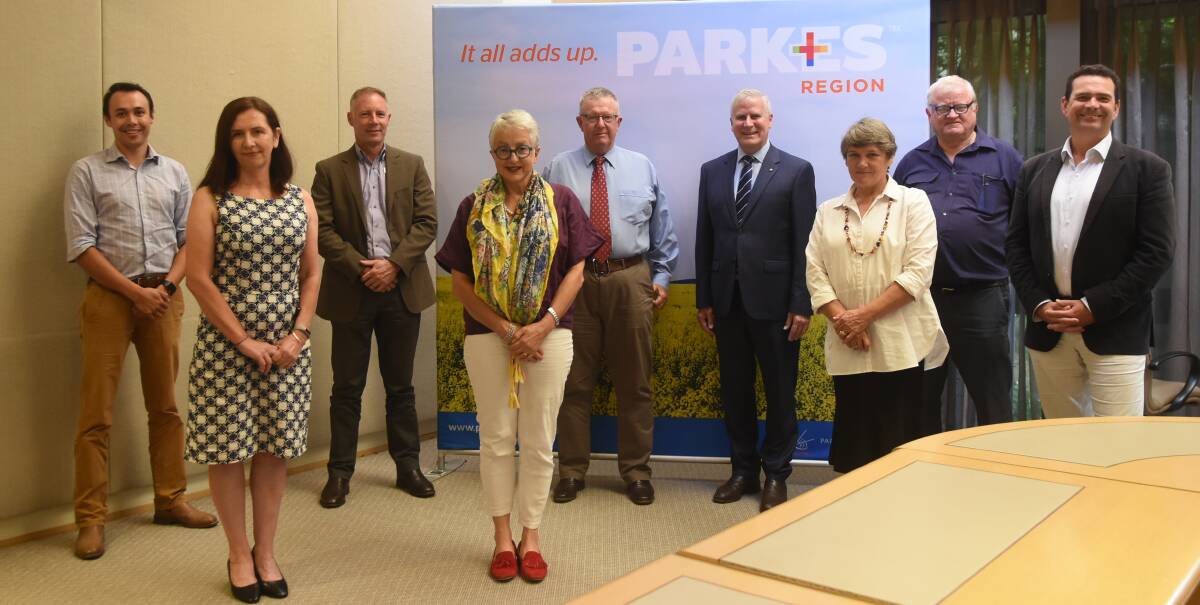
Working together to attract health professionals to our region is the goal of a meeting of minds held in Parkes this week.
Subscribe now for unlimited access.
or signup to continue reading
Forbes and Parkes, and the "4Ts" of Trundle, Tullamore, Trangie and Tottenham were two of the sub-regions identified as part of a collaborative care project funded to the tune of $5 million in the Federal Budget.
National Rural Health Commissioner Professor Ruth Stewart met with Deputy Prime Minister Michael McCormack, Federal Regional Health Minister Mark Coulton, representatives of the Rural Doctors Network, Western NSW Local Health District and the Western NSW Primary Health Network to launch the program, before the groups sat down with our councils and community representatives.
Mr McCormack said an ageing GP workforce had been identified as a challenge facing the region, and collaborative care was bringing councils, community and health professionals together to work on solutions.
Mr Coulton said the models focus on "sub-regions" rather than individual towns to address healthcare access issues.
"By servicing multiple towns, there is an opportunity to achieve economies of scale, create sustainable practices and provide better access to primary health services for rural and remote Australians," the Deputy Prime Minister said.
READ MORE NEWS STORIES:
Richard Colbran, chief executive rural doctors network, told the gathering the challenges facing rural health recruitment are real but not insurmountable.
And it's not a matter of needing more funding, but being strategic in the use of Federal and State funding already available.
"What we've come to see is that the whole landscape is changing," he said.
"The whole idea of a doctor coming to one town for 40 years - that's all gone now, we just cannot keep thinking that way.
"If we can retain a doctor for three to five years in a local community, that's a massive success.
"What we think collaborative care can do is try to have a conversation that takes us away from the individual needs of one particular people or organisation or town and think more broadly about the local community in a broader context.
"When we can think a bit more broadly and use the resources that are available to us, we can make a sub regional approach work.
"It doesn't mean we're taking anything away from a community, we don't believe. We're actually listening to what the community needs.
"What we've now realised - we've seen this in the 4Ts - where a single general practice in each of those towns is actually not sustainable at the moment.
"But if we come together, if we have the communities participating, thinking and talking together ... we can build a primary health care service across the four towns that has fully supported medical service and allied health, nursing service across the four towns.
"Those doctors can move across those four towns and be successful."
Federal funding allocated in the most recent budget, will allow the team to formally sit down and how to structure services.
Federal Rural Health Commissioner Professor Ruth Stewart said a collaborative approach could see more cooperation such as the shared Lachlan maternity service across Parkes and Forbes.
It's about ensuring health and allied health services in a sub-region work together rather than in competition.
"By joining the service, the people who work in the services, they experience less professional isolation," Professor Stewart said.
Minister Coulton said it was about making sure practitioners felt supported.
"If there was a storeroom of doctors we could send to regional Australia, we'd be shovelling them out the door. But the truth of the matter at the moment, is that there is not," he said.
"Part of the collaborative health model is having the practitioners supported so they don't feel like they're going to be here for 80 hours a week on call all the time.
"They're part of a larger team, so they can get that work-life balance."
Training rural students through the Murray Darling Medical School, providing them with well-supported rural placements, and ensuring they had a breadth of training to feel confident to work in rural communities are all keys, Mr Coulton said.
But he clarified that Parkes and Forbes are only at the start of the process, sitting down this week to start working on what it might look like. What they're not trying to do is find a "one-size-fits all" model.
"What we're saying is, we are prepared to back the model that you come up with," he said.
Mr Colbran adds that it is critical to acknowledge our existing workforce.
"The challenges are real for those who are already working in rural NSW," he said.
"We're very concerned that our health workforce is not being celebrated and congratulated for their very deep commitment to their communities."
What do you think?
Send a letter to the editor by filling out the online form below.
Our journalists work hard to provide local, up-to-date news to the community. This is how you can access our trusted content:
Bookmark www.parkeschampionpost.com.au
Follow us on Facebook
Follow us on Twitter
Follow us on Instagram

